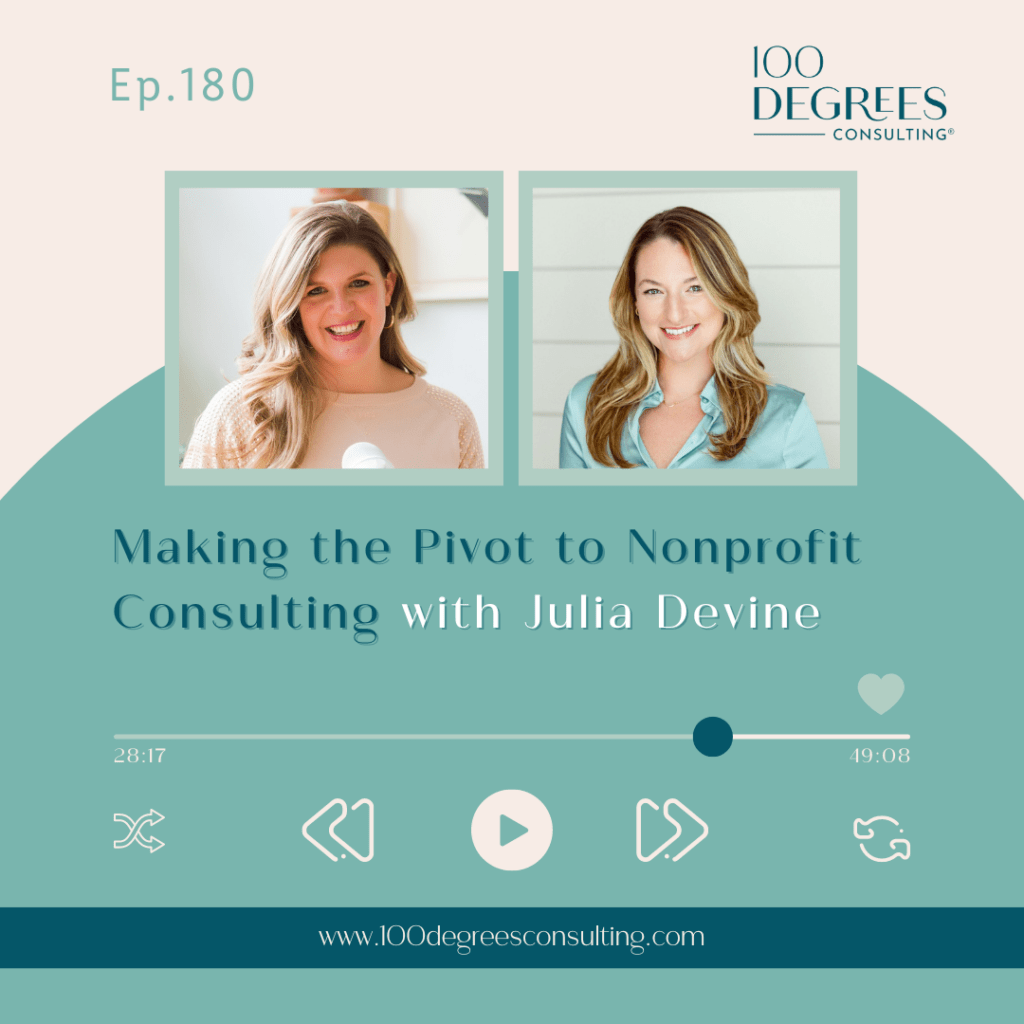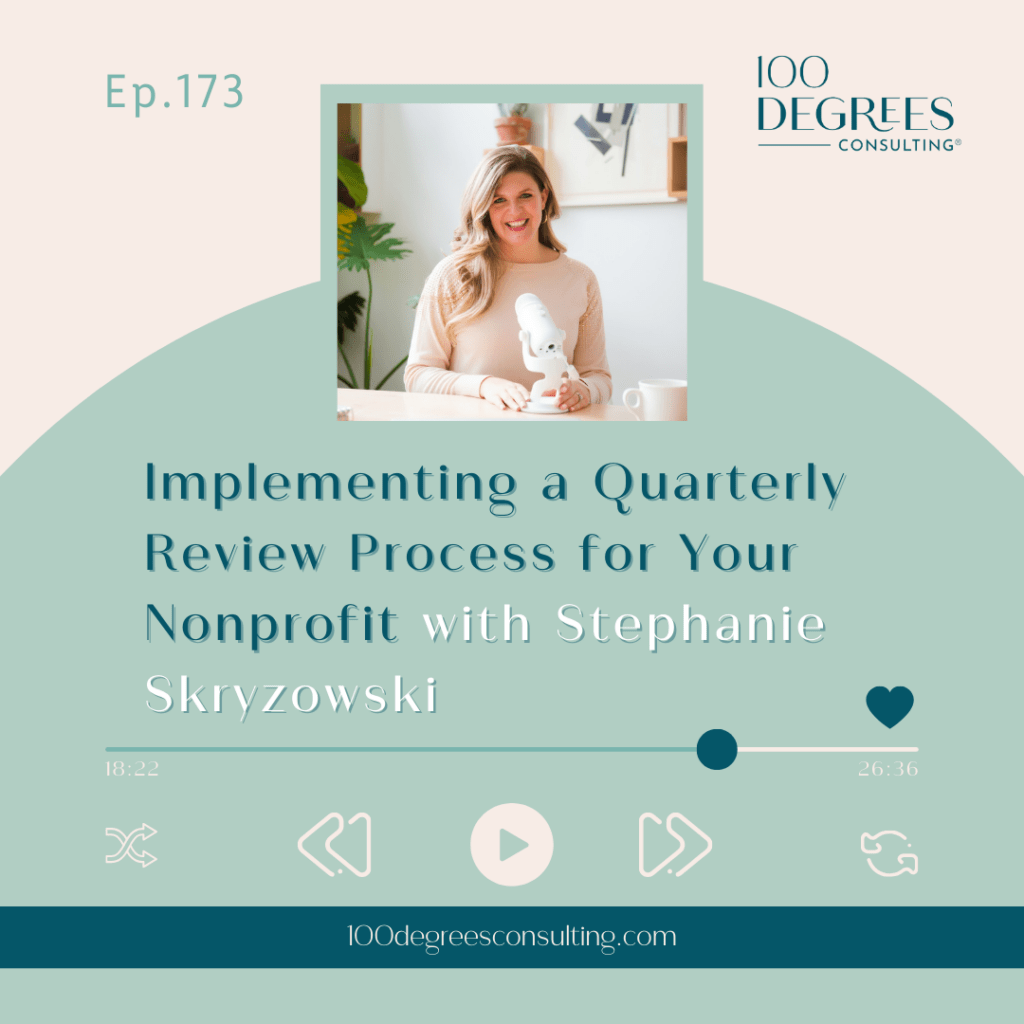Transcript Episode 153 – Overcoming the Challenges of Inflation on The Prosperous Nonprofit
Stephanie Skryzowski: [00:00:00] Welcome to the Prosperous Nonprofit, the podcast for leaders who are building financially sustainable and impactful nonprofits and changing the world. I’m Stephanie Skrzewski, a chief financial officer and founder and CEO of 100 Degrees Consulting. My personal mission is to empower leaders to better understand their numbers, to grow their impact and their income.
On this show, we talk to people who are leading the nonprofit sector in new. innovative, disruptive, and entrepreneurial ways, creating organizations that fuel their lives, their hearts, and their communities. Let’s dive in.
Hey, everybody. Welcome back to the Prosperous Nonprofit. I am so excited you’re here. We have a topic today. I’m, I’m chuckling a little bit because I’m so excited you’re here and we are talking about inflation. Ha ha ha. Um, I’m [00:01:00] joking and also I’m serious at the same time. This topic came to my mind recently because of several things that have been happening in my world.
And so I wanted to share it with you and then give you some ideas on how you as a nonprofit leader can help deal with the rising cost of basically everything in your organization. So a couple of things that have come to me recently are first, we just did our health insurance renewal and open enrollment for 2024.
And our health insurance costs are going up something like, I don’t know, maybe 30%, 20 or 30%, something like quite significant. And I didn’t want to put this cost increase on our team. And so instead, the amount that we as a company are contributing to health insurance is going up by 20 or 30%. So that.
our employees can [00:02:00] basically be paying the same amount that they were paying in. So our employees pay a very small portion and then 100 Degrees pays a portion, a much more significant portion. And so now in order to make sure our employees are able to continue paying that very small portion, we as a company have to pay a lot more.
So that was like, oh boy, something we need to deal with. The other thing that I’ve had several conversations about recently are around audit fees. And so, as you know, our company, 100 Degrees, we don’t do audits, but we work with a lot of auditors, a lot of audit firms. And I have had two conversations recently with nonprofit organizations that are working to actively reduce their audit fees.
They’re like, we are paying so much money and we’re having a really tough time with our budget for next year and our funding. And so we need to find a cheaper audit firm. And so I have shared this with two different auditors and they’ve both [00:03:00] said, we are, have to raise our prices 15 to 20 percent this year to keep up with our costs.
And so it’s very unlikely that we’re going to be able to do a whole lot when it comes to reducing the cost of the audit. Right. So. Basically, like, non profit audit clients, so non profit organizations, should be grateful if their price doesn’t go up at all because audit firms are raising their prices 15 20%.
Um, and so, I thought that was super interesting. And then, I was doing research for Um, a presentation that I just did around hiring as a small business owner and just reading so much about salaries and how nonprofit organizations and small businesses alike are having so much trouble, um, finding retaining.
really solid talent because salaries are so high and we just can’t afford to pay them, right? And so as a result of all of this internally at [00:04:00] 100 Degrees, we have also been having conversations about raising our prices and have had to do that with a number of our clients, many of which we have not touched their prices in years.
And so, you know, it feels okay to, to do that, but it’s still really, really hard. It’s hard on us as a business owner to see all of our costs increasing. And so then having to subsequently increase our prices, which is then impacting the nonprofits that we work with. All of their costs are going up and it’s just like this sort of endless circle of just needing more money, right?
And so my first thought was like, where do our funders fall into this, right? Are we communicating with our funders that like, hey, listen, this 100, 000 grant that we promised would do X, Y, Z? two years ago is just simply not enough to have [00:05:00] those same outcomes and do those same things in today’s economy, right?
So are we having those conversations with our funders and telling them, listen, this is not enough anymore. Like all of our costs are rising, say 30%. So we are going to request 30 percent more in order to do. The same work right in order to get the same outcomes. Are we having those conversations and that’s not Actually, a rhetorical question.
I want to know, I want to know, are you having those conversations with your funders and saying, listen, the same 100, 000 that you were giving us three years ago is not going as far these days. Today we need X amount, again, 130, 000, 150, 000 in order to do the same work and achieve the same results. I want to know if you’re having those conversations.
I want to hear about them. I would love to talk to you. In fact, I’d love to chat with you on the podcast. So send me an email. Y’all know where to find me. Stephanie at 100DegreesConsulting. com is my email. Send me a note. [00:06:00] Um, I would love to hear if you’re having these conversations with your funders. I was in a workshop a few weeks ago where someone mentioned, um, that they are having those conversations with their funders.
In fact, they, You know, put together a budget and their funder said, okay, here’s your sort of top line amount that you can request. And they came back and said, listen, our people are really, really good. And also they are all going to leave us if we cannot pay them more competitive salaries. We are very, very far under the market right now and we need to get them up to basically market rates so that we don’t lose them because they’re awesome.
And it’s going to cost us so much more. If we then have to replace them, and in fact, We’re going to have to pay those higher salaries anyway to get new people on board. But now we’re also going to have to train people or get somebody more junior and less experienced. Right? So it’s this whole ripple effect.
Anyway, they [00:07:00] told their funder this and their funder stepped up to the plate. Their funder said, yeah. Yeah. Yeah. We get it and we will help you and give you more money to be able to pay your people appropriately. Now that is what I love. That is forward thinking. That is not short sighted. That is working with sustainability and longevity of these organizations in mind.
But sadly, I don’t feel like these conversations are being had often enough. Do you all follow Vu Le? It’s V U L E. He is basically like a non profit influencer, and he recently posted something called Non Profit Math. So if you just Google Voulet Non Profit Math, you’ll find it. But he wrote 21 non profit math problems that expose the absurdity of doing good.
And it was really a play sort of following the trend on social media about like boy math, girl math, corporate math. So if you don’t know what I’m talking about regarding that trend, it doesn’t matter. [00:08:00] Just Google Voulet nonprofit math and he posted something, a couple of things that I think are so relevant to what we’re talking about when it comes to salaries and inflation and communicating with your funders about like, listen, our dollars are not going far enough anymore.
So number 10 on his list of 21 nonprofit math. Challenges are, he says, non profit math is when an awesome staff asks for a raise of 5, 000 and gets denied, so they quit. But no one would work at the current salary, so the organization now has to raise the salary. 10, 000 and now has a less experienced staff member on board, right?
Like it just, it’s so short sighted. It’s so short sighted. And so I want to know, are you having conversations with your funders about this? If this is in fact a big challenge for you, if you are, please reach out to me because I would love to talk more about this. I think that is really the only way that we are ever going to change the sector, right?
That we [00:09:00] are ever. Um, going to be able to spend more than say 15 percent on administrative overhead, right? Is if we have these conversations and if we are bringing them to the table. So if you are talking about this, I want to know, I want to talk to you more about it. Okay, so if you are like us, like me as a small business owner, I’m dealing with the challenges of inflation, the challenges of rising salaries.
Literally every single day I have a team of 16. This is a very, very top of mind for me. If you’re dealing with the same thing, I have a few different things that you can think about to kind of help you work through this issue, right? We can’t change the economy, unfortunately. We can’t change salaries. We can’t change like what is real and true and happening right now, but there are a couple things that we can do to help us work through it.
So the first thing is financial planning, right? You all hopefully knew by now that that is exactly what I would say. Financial [00:10:00] planning. We need to have a forecast where we are proactively looking at our revenue and our expenses that are coming up that are going to happen in the future so we can project, okay, if these are our expenses, well, what does our revenue need to be in order to match that?
Can we Okay. increase our revenue, or can we decrease expenses to make these things line up a little bit better so that we can continue moving forward, right? So using a financial forecast, y’all know I’ve shared this probably a million times on this podcast, but if you don’t already have our cashflow template, if you go to 100 degrees consulting.
com slash cash. You will get a free template there, a free workbook to be able to forecast your revenue, your expenses and your cashflow. So if you’re not using that already, that’s really going to help you manage through some of this and give you visibility into the future. So basically, okay, we know now that, you know, our salaries [00:11:00] need to increase.
Say 10% this year. Okay, well, what does that do to our cash flow? How does that impact the amount of money that we actually have in the bank? Right? So forecasting super, super important.
Hey there, amazing listeners. I hope you’re enjoying another fantastic episode of the Prosperous nonprofit. Before we dive back in, I have a quick favor to ask. That’s right. If you are getting value, knowledge, encouragement, or even just good vibes from our show, please share the Prosperous Nonprofit with a friend or colleague who you think would love it as much as you do.
It’s like passing along a good book or recommending your favorite local coffee spot. Please take a quick second to hit that share button, send a link, or even give a shout out on social media. Your support means the world to me. Thank you for being awesome. Thank you for being here. And now back to the show.
The [00:12:00] other thing that we can look at in times when inflation and rising Cost and rising expenses are a thing, is looking at our revenue, right? We want to really reduce our dependency on a single funding source and really start trying to diversify our income streams. And so there’s a lot of different things that we can think through here.
But first of all, thinking about opportunities for earned income. Um, like fee based services or partnerships or something that doesn’t require you going to a funder and asking for a big chunk of money because at the end of the day, while some funders may be fantastic and like, yeah, I understand that things cost 30 percent more now, so we’re going to give you 30 percent more because we can, there are going to be other funders That say no for whatever reason, maybe they can’t.
Um, maybe they’ve got different priorities and or maybe they’re just choosing not to right. It, it doesn’t matter the reason why, but some funders are not gonna be able to do that. So we want to really [00:13:00] diversify our revenue so that we’re not relying on a handful of people that are not able to give us more money to meet these rising costs.
And earn income is a really interesting way to do that, because that you have the power yourself, right? That power is in. your hands to be able to increase that, that revenue stream. The other thing to think about, and this is a tricky one for me to talk about, but it’s negotiating vendor contracts. And so, thinking about where are you spending the most money and where can you make changes now?
Um, you know that I do not advocate for scrimping and saving and doing the bare minimum, right, in order to save a buck. I do not advocate for that because what I believe is that that causes inefficient organizations and I do not believe in operating on a shoestring. I believe in having the resources that you need to be most effective and yes, that costs money.
Okay. I will die on that hill. [00:14:00] I There may be services with vendors and other service providers that you don’t actually need and or where you might be able to secure better agreements and better terms, right? So maybe you are paying a service provider for a service that you don’t really need. Maybe you were optimistic when you signed that agreement and you thought you would use it and you thought it would do something particular, you know, you had a goal for it and it turns out, well, we’re just not really using it to its fullest potential.
Well, that’s a great opportunity to, um, Let it go, right? And save a little bit of money where you could. Again, I am not advocating for scrimping and saving and getting rid of essential things. I’m just saying it’s a good opportunity to just take a look at what we’re paying money for and to make sure that it makes sense.
The other thing to think about is payments. You know, so right now, if you’re paying for something in full, [00:15:00] Maybe it would be a good opportunity to shift that to a monthly payment plan and instead of the upcharge that often happens with a monthly payment plan, just ask, Hey, well, can we still pay the same amount total, but just get on a monthly payment plan?
And a lot of times a vendor or service provider would rather do that and give you a little flexibility on when you’re giving them money versus losing you entirely as a client or customer. So that’s something that. You know, don’t be afraid to be creative and to propose, um, some creative solutions. I know that some of our clients, when we have had to raise prices, again, it’s like so difficult.
I hate doing it, yet it is also necessary because I too need to make payroll for my incredible team. When we have provided creative solutions for our clients to help them save money or when clients have come to us and said, Hey, can we do X, Y, and Z that, that would really help us cashflow wise. I’m almost always going to say yes, because again, I care [00:16:00] about them.
I want to be able to still provide the services that we do, but also understand their situation. So I’m like, yeah, let’s, let’s do it. So I would encourage you to think about that. Now is the time to, to really think about your reserves, your cash reserves, or Hopefully not, but perhaps lack thereof, right? We want to make sure that we have extra money in the bank because we don’t know what’s going to happen.
Who knows what prices are going to turn into? Who knows where inflation is going? And hopefully, like, it’s not going to be driven up any further, but who knows? And so, right now, if inflation hasn’t really impacted your organization in a, uh, in a material or, you know, meaningful way, now’s the time to really start thinking about your cash reserves.
And if you don’t already have three months of cash in the bank, I would strongly encourage you to figure out what that number is. So what does three months in the bank, what is three months of cash equal for your organization, [00:17:00] right? For some organizations, it’s 100, 000. For other organizations, it’s 3 million, right?
So think about for your organization, what three months is, and then start. And doing a little bit of math, get out that calculator and figure out, okay, over the next, say six months, if we wanted to get to that goal number, how much extra money do we need to pop over into our savings account every single month to get there?
Right? So this is just going to give you that, that peace of mind to have a, a cash reserve set aside. And just help make you stronger as an organization and, and help protect a little bit against the inflation and the rising costs that we’re seeing. So this other idea that I have, we’ve been talking about really inflation adjusted fundraising.
And basically what I mean is like, let’s just ask for more money. Right? So with some grants, um, that you have, maybe there are, there are limits. So instead of, um, I used the example in the [00:18:00] beginning, you know, a 100, 000 grant two years ago, maybe now it’s going to cost 130, 000. Okay, well, if there’s a cap on the grant.
You know, the proposal on the application, you can only ask for 100, 000, okay, well, let’s adjust our outcomes then, right? Let’s not try to do the same exact thing for less money. Let’s do less for the same amount of money, right? Like we need to make sure that this is balanced here. So adjust your fundraising accordingly.
And so whether that means like scaling back your outcomes and your deliverables based on how much money you’re able to, to get, or if you’re talking about like, Um, asking of major donors, adjust your ask accordingly. So if you asked a major donor last year for 250, 000, well, maybe this year you’re going to ask for 500, right?
And it doesn’t necessarily need to be aligned with inflation, right? Inflation is not 100%, but I think we need to be, and now listen, y’all, I’m not a fundraiser, but. [00:19:00] I’ve read a lot about asking for more, right? And the worst that they could say is no, and the best that they could say is yes, right? And I was listening to, I think I was listening to it.
It was, I believe, oh my gosh, I believe it was a podcast episode on the We Are For Good podcast and I believe the We Are For Good team was interviewing, um, Scott Harrison of Charity Water. I’m terribly sorry if I’m like totally off base and I’m not identifying the podcast episode correctly, but I’m pretty sure that’s what it was where he just, you know, he had sort of like a baseline of what he would go to donors for.
And, you know, maybe first it was 50, 000 and then he would ask for a hundred thousand. And before long, he was asking donors for a million dollars. He was getting comfortable with just. Asking for bigger numbers. And so when we’re talking about inflation adjusted fundraising, we need to ask for more money, right?
And we don’t need to talk about it like we’re asking for more because of inflation and the inflation rate in the United [00:20:00] States is blah, blah, blah. No, you don’t need to do that. Just need to ask for more money, right? And so if last year, again, your big gift ask was 250, ask for 500 this year. And even if they come back and be like, we can’t do five, but we can do, you know, 400 or three 50, like, Hey, listen, that’s better than the two 50 s four last year, right?
That can help, you know, fill some of this gap. So inflation adjusted fundraising. So listen, friends, I hope that, first of all, I hope your organization is not being impacted in a meaningful way regarding inflation, but. I have a feeling it probably is based on everything that I’m seeing as a leader of a small business.
It is impacting us in a big way, and I am navigating how to deal with this as a small business owner. You know, how can we still pay competitive salaries? How can we still cover benefits? And how can we still really be a good business? servant to our nonprofit clients and not put taxing increases on them.[00:21:00]
But like the math isn’t mathing, right? The math does not math. If we don’t raise our prices, then we can’t afford these salaries. That means we can’t have incredible people on our team. Like the math has to math. And so Think about that in your organization. If the math isn’t mathing, then something has to change, right?
Whether fundraising has to increase or expenses need to decrease, preferably not the latter, right? Because we do not want to sacrifice quality of our programs. We need to be thinking about this. So if it hasn’t impacted you already, well, I am very happy for you. If it has impacted you and you’re starting to see, you know, the impact of increased salaries, increased health insurance, increased expenses overall, I feel you.
And also I hope that some of the things that I talked about today can help you navigate through this and, you know, come out on the other side even stronger than ever. So I appreciate you being here. I would love if you would share this episode with a friend. [00:22:00] If you know another nonprofit leader who needs to hear this, please, please, please share the Prosperous Nonprofit with a friend.
I would love to have more amazing nonprofit leaders in our community. All right, friends, until next time, see you later. Before you go, I just want to thank you for being here. To access our show notes and bonus content, visit 100degreespodcast. com. That’s 100degreespodcast. com and I’ll see you next time.



















